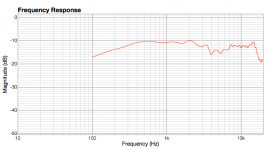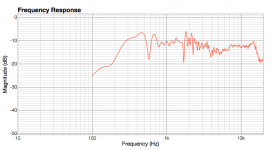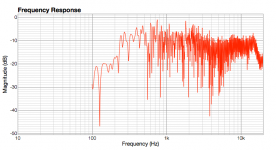What's the difference between "constant" directivity and "uniform" directivity? I've heard that uniform is important and constant not.
It's windowed of course. Who has an anechoic chamber? 🙄
Well windowing is just like smoothing - how much depends on the gate length...
What's the difference between "constant" directivity and "uniform" directivity?
There is none, or rather, there shouldn't be any difference. A speaker with true uniform or constant directivity doesn't exist.
Markus,
And yet that is the entire conversation about using conic section horns is a true constant directivity which I don't believe is ever possible but the argument behind all these types of designs. Same with the Oblate Spheroid.
And yet that is the entire conversation about using conic section horns is a true constant directivity which I don't believe is ever possible but the argument behind all these types of designs. Same with the Oblate Spheroid.
Markus,
And yet that is the entire conversation about using conic section horns is a true constant directivity which I don't believe is ever possible but the argument behind all these types of designs. Same with the Oblate Spheroid.
Quite frankly, all those discussions about directivity are just another audiophool distraction from what is really important in sound reproduction in small rooms. Instead of trying to find answers to the important questions, people get hung up on their beliefs.
Listening rooms are usually highly reflective at most frequencies, which creates substantial comb filter effects, and brings to life the directivity pattern of the speaker. Imagine a speaker that gets more and more directional up to about 2kHZ, and then suddenly becomes much less directional above 2kHZ... (8 inch woofer crossed over to a one inch dome tweeter, for example). What would you expect the overall feel of the sound to be like, especially in smaller rooms? Answer: Even if the speaker system measures flat, on axis, in an anechoic chamber, you'd hear much more energy in the upper midrange, right where the ear is most sensitive, and the coloration from the abruptness of the transition. LOTS of speaker designs made this mistake.
^ Depends on D/R ratio. If you're listening within the critical distance (direct sound >= reverberation) the direct response is more important than the energy response. The opposite is true for listening beyond the critical distance. Speaker directivity has a significant effect on critical distance.
Bob,
We aren't comparing direct radiators to horn systems. But the argument that some of these constant directivity horns are so much better than a very well designed exponential or other horn is where I see the argument really. I personally don't believe that in a small room there is as great a difference that you need to worry at the level that is placed here. Just my opinion.
We aren't comparing direct radiators to horn systems. But the argument that some of these constant directivity horns are so much better than a very well designed exponential or other horn is where I see the argument really. I personally don't believe that in a small room there is as great a difference that you need to worry at the level that is placed here. Just my opinion.
Well windowing is just like smoothing - how much depends on the gate length...
No its not. There is no smoothing with a window above its "cutoff" frequency. Below there is, but that's at 200 Hz in my data.
Earl is right on that one, why would a simple windowing function smooth a response curve? It only makes it possible to remove the room response from the analysis.
Earl is right on that one, why would a simple windowing function smooth a response curve? It only makes it possible to remove the room response from the analysis.
5ms, 10ms, 50ms window - same measurement:
Attachments
Markus,
I am thinking of a swept window function that would follow a sine wave type of excitation. An MLLS type of waveform with a windowing function that tracked the output.
I am thinking of a swept window function that would follow a sine wave type of excitation. An MLLS type of waveform with a windowing function that tracked the output.
^ Most available software derives an impulse from a swept sine recording. The rest is just transformations. So it just would needs to vary the window with frequency when deriving the magnitude response. Most software doesn't offer that functionality.
No if doesn't Markus. That is why I go to a friend who has all the B&K test equipment that can work with modern software packages and track the signal. The only way I know of to get anechoic measurements without a chamber. But it isn't something that most people are going to own, this is capital intensive equipment.
Markus - it would be helpful if you explained your plots above. Isn't the difference between them just how many reflections are included? Taking those out isn't smoothing in the sense being talked about here though is it? If your point though is that we listen to speakers in real rooms with a response like the third, then it must be right that one should remember that - but how does it move this debate on? I.e., what do we do about the response in the third graph? It's certainly interesting!
Stephen
Stephen
Markus - it would be helpful if you explained your plots above. Isn't the difference between them just how many reflections are included?
Yes and no. The longer the window, the more reflections are included. The shorter the window, the coarser the frequency resolution becomes. But, more important is the question how we relate measurements to perception.
Last edited:
If you do a sine sweep of a relatively flat hi-end speaker up close (3 ft.) and away from any walls, and then do the same sine sweep 6-8 ft. away in a typical living room, you'll notice that the rooms contribution is very significant. Using tone bursts in a gaussian or "Blackman" envelop will show any room ringing better. Larger rooms will usually do a lot less damage since the intensity of sound drops off generally logarthymically with distance, unless the room gets so big that reflections start happening with delay times over 50mS, in which case intelligablility will become difficult (according to David Griesinger of Lexicon). In any room I've ever lived in, the off axis room contribution has been substantial.^ Depends on D/R ratio. If you're listening within the critical distance (direct sound >= reverberation) the direct response is more important than the energy response. The opposite is true for listening beyond the critical distance. Speaker directivity has a significant effect on critical distance.
- Status
- Not open for further replies.
- Home
- Loudspeakers
- Multi-Way
- Uniform Directivity - How important is it?


